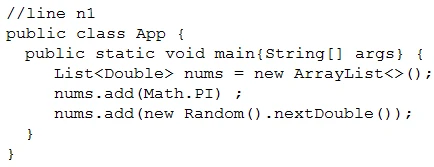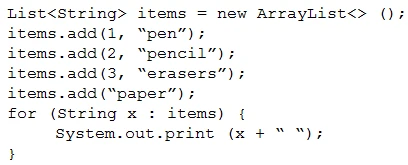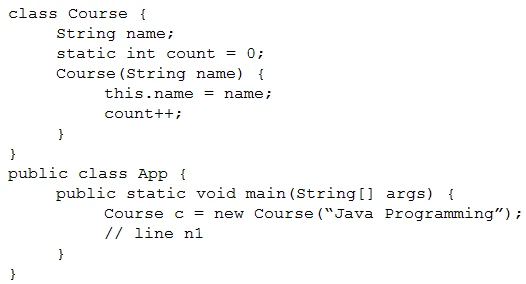
Which two code fragments are valid at line 2?

The correct options are those that conform to Java syntax rules within a class body. Option A is valid because it includes a for loop and a print statement, both of which are valid inside a method definition in a class. Option B is invalid because 'package p1;' must be declared at the beginning of the file, not inside a class. Option C is invalid because import statements must be at the top of the file, and non-static block cannot have method declarations. Option D is invalid because a block cannot directly contain member variable declarations. Therefore, Option E is valid because it includes member variables and methods inside the class body according to Java syntax rules.
The enhanced for loop cannot be used to traverse an array in reverse order. This type of loop is designed to iterate over elements from the beginning to the end, providing no means to control the iteration direction. On the other hand, standard for, while, and do-while loops offer the flexibility to control the index variable, making it possible to iterate through the array in reverse order.

The code will not compile because the Random class, ArrayList class, and List interface are part of the java.util package, which needs to be explicitly imported. The Math class is part of the java.lang package, which is automatically imported. Therefore, importing java.util.* at the beginning of the code will resolve the compilation errors.

The given code attempts to add elements to specific indices in an ArrayList without populating the list up to those indices first. In Java, the ArrayList's add(int index, E element) method throws an IndexOutOfBoundsException if the specified index is out of range. Initially, the ArrayList is empty, so trying to add an element at index 1 or greater will result in an IndexOutOfBoundsException. Therefore, a runtime exception is thrown.

The correct code fragment to enable the code to print 'Java Programming:1' is 'System.out.println(c.name + “:” + Course.count);'. In this code, 'c.name' accesses the instance variable 'name' of the object 'c', which was assigned the value 'Java Programming'. 'Course.count' accesses the static variable 'count' of the class 'Course'. Since 'count' is incremented in the constructor when 'new Course("Java Programming")' is called, 'count' will be 1. This results in the output 'Java Programming:1'.